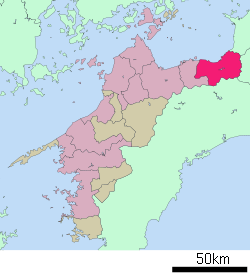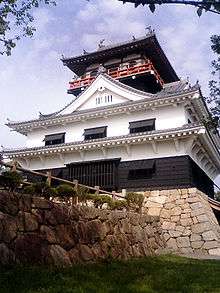Shikokuchūō
Shikokuchūō (四国中央市, Shikokuchūō-shi, lit. "Central Shikoku City") is a city located in Ehime Prefecture, Japan.
Shikokuchūō 四国中央市 | |
|---|---|
Doi Taiko (Japanese drum) Festival, held on October 13 to 15 every year | |
Flag  Emblem | |
 Location of Shikokuchūō in Ehime Prefecture | |
 Shikokuchūō Location in Japan | |
| Coordinates: 33°59′N 133°33′E | |
| Country | Japan |
| Region | Shikoku |
| Prefecture | Ehime Prefecture |
| Government | |
| • Mayor | Takumi Ihara (since April 2004) |
| Area | |
| • Total | 421.24 km2 (162.64 sq mi) |
| Population (June 1, 2019) | |
| • Total | 83,918 |
| • Density | 200/km2 (520/sq mi) |
| Time zone | UTC+9 (JST) |
| City hall address | 4-6-55 Miyagawa, Mishima, Shikokuchūō-shi, Ehime-ken 799-0497 |
| Website | city |
Shikokuchūō is the leading producer of paper and paper products in Japan.[1] It is also a port city and one of Ehime's major centers of industry.
As of June 1, 2019, the city has an estimated population of 83,918, with 38,941 households,[2] and a population density of 199 persons per km². The total area is 421.24 km².
History
Shikokuchūō is part of the former Uma District. As Uma is centrally located in Shikoku, it was historically a transportation hub between Shikoku's major cities. Due to its strategic importance, during the Sengoku period Uma was repeatedly invaded by the neighboring domains of Sanuki, Awa and Tosa.[3] Forts were built in the east part of Uma to protect against these invasions.
Industry began to flourish in Uma during the Edo period, and the city grew as a port town. The Tosa kaido offered access to Tosa in the south, so Uma was also a stopping spot, or ‘post station,’ for the Tosa daimyō and travelers to and from Tosa.[4]
Paper making began in Uma around 1750,[3] and much later grew into the region's major industry.
Government and naming
Shikokuchūō city was founded on April 1, 2004 when the cities of Kawanoe, Iyomishima, the town of Doi and the village of Shingū merged to form one new city. The name literally means "Shikoku Central City" and was so named in the hopes of becoming the new capital of the island of Shikoku, should the four prefectures be merged into one state.
However, this name has been roundly criticized for its unoriginality, and is known as one of the "strange city names" throughout Japan.
The former cities of Kawanoe and Iyomishima (the two largest cities of the four that merged) have fought for political control over the new city.
Paper industry
Shikokuchūō is the leading producer of paper and paper products in Japan.[1]
The history of the paper industry extends back to around 1750, when washi was first produced in the Uma area.[3] The area does not have much flat land, and is ill-suited to rice farming, but as water and the proper kind of wood are plentiful, it is ideal for paper manufacturing.[5] The modern paper industry began to flourish when mechanized manufacturing techniques were developed in the Meiji era. After World War II, the paper industry contributed to the city's rapid economic growth.
The city paper museum, Kami no Machi Shiryokan, has exhibits and information on traditional paper making and the modern paper industry.
Sites of historic and cultural interest
Manabe house
The Manabe house is the oldest extant minka (traditional Japanese house) in Ehime, and is designated as a national cultural treasure. The house was built by the Manabe family, who were descended from members of the Heike clan who fled to Shikoku after the Heike's defeat in the Genpei War.
Junshin-do
The Buddhist monk Junshin dwelt here after he was expelled from Tosa province (modern day Kochi). As is described in the lyrics of the Yosakoi naruko dancing song, Junshin had an illicit affair with a comb-maker's daughter, and the two of them attempted to elope. After they were caught leaving Tosa without permission, Junshin was permanently expelled from Tosa, and the two of them were separated. Junshin lived in this building for the remainder of his life.
Kofun
Many burial mounds, or kofun, were built in the area during the mid to late Kofun period. These include the Toguzan burial mounds, the Kyogaoka burial mounds (circa sixth century AD), and the Mukaiyama burial mounds (early seventh century).[3] The Toguzan kofun is said to be the grave of crown prince Kinashi no Karu no Miko, son of the nineteenth emperor, who in the Kojiki was banished to Iyo by his brother.
Tosa Kaido
The Tosa kaido is a direct route over the mountains between Tosa (modern day Kochi) and Iyo (modern day Ehime) that was used from ancient times to the Edo era. In Shikokuchūō, the road starts in Kawanoe, passes through Shingu, and continues to Sasagamine ridge in Otoyo Town, Kochi. Parts of the road date back to 793, when it was made an official government route of the Daijo-kan (the central government in Kyoto).[6] The road later fell out of use by the government, but continued to be used by travelers and people in Shikoku for the next nine hundred years. From 1718, the Edo shogunate began to use the road for sankinkotai, the policy of forcing the daimyō of every han to move periodically between Edo and his han.[4]
In recent years the Tosa kaido has been maintained through the efforts of volunteers. Hikers can walk on a footpath from Kawanoe to Otoyo, Kochi. (The path sometimes joins Ehime prefectural road 5.)
Kawanoe Castle

Kawanoe Castle was built in 1337 at the beginning of the Nanboku-cho period. For the next several hundred years, it was attacked repeatedly by armies from Sanuki, Awa, and Tosa. It fell to the armies of Toyotomi Hideyoshi in 1585, when he conquered Shikoku. The castle was torn down in 1611, and some of it was used for Matsuyama Castle.
In 1984, Kawanoe City began a project to rebuild Kawanoe Castle. Construction was completed in 1988.[7]
Shodo Girls
The 2010 movie Shodo Girls!! Watashi-tachi no Koshien was filmed in Shikokuchūō. The movie is about a high school calligraphy club which prepares to compete in the "Shodo Girls Koshien"—a performance calligraphy event involving teams drawing on 10m x 12m sheets of paper while performing to music. Shodo Girls is based on a true story.
Sport
One player in Japan national bandy team has come from the city.
People from Shikokuchūō
- Ken Kamakura, baseball player
- Minoru Shiraishi, voice actor
- Yoshikazu Shirakawa, photographer
- Kiyonori Sokabe, trumpeter
- Kumiko Takahashi, drummer (chatmonchy)
Notes
- "City of Shikokuchuo English Web Site" "Outline of the City" Archived July 18, 2011, at the Wayback Machine
- "Official website of Shikokuchūō City" (in Japanese). Japan: Shikokuchūō City. Retrieved May 25, 2017.
- "City of Shikokuchuo English Web Site" "History and Culture" Archived July 18, 2011, at the Wayback Machine
- Ehime-ken Bunka Shinko Zaidan. Ehime no Furusato Komichi, Higashi Iyo-hen. 1982, p.178 Japanese
- Kami no Machi Shiryokan pamphlet, English
- Ehime no Furusato Komichi, Higashi Iyo-hen, p.178 Ehime-ken Bunka Shinko Zaidan, 1982 Japanese
- Kawanoe Castle pamphlet, English version, Kawanoe kanri jimusho
External links


- Shikokuchuo City official website (in Japanese)
- Shikokuchuo City official website